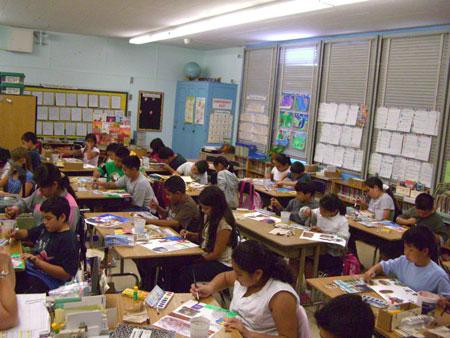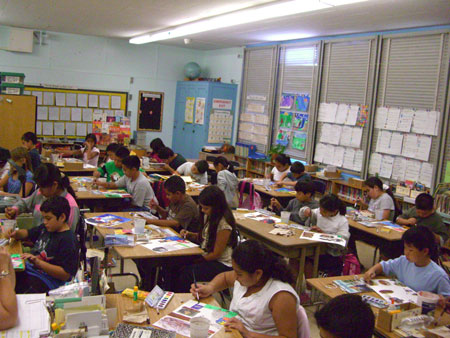Encouraging children to engage with art is a big part of what we do here at LACMA. Recently, Jane Burrell wrote about our LACMA On-Site program that reaches out to engage youth in classrooms, libraries, community centers—and, of course, here on site at the museum. This time, I’ll share some insight into how we measure the impact of that initiative, because it speaks to the depth of our commitment to the communities we serve.
In 2008 and 2009, a team of LACMA educators and independent evaluator Susy Watts developed an evaluation methodology and conducted an eleven-month evaluation of the project. At the heart of this work was determining the learning impact as well as the social impact on participants. In particular, we sought a way to show the effect of the work. We were curious about what they know and show us, what they are able to do as seen in their art and the processes they use to talk about art, and their habits of mind—the way they act in specific conditions.
We chose an evaluation method called Theory of Change to help us refine our understanding of our purpose and attach specific outcomes and indicators. Specifically, our goals were that participants would talk about art using detailed and descriptive language, make art using a range of materials and applying specific skills and techniques for each material, recognize personal connections between their own art, their own life, and LACMA artworks, and integrate arts programming with language arts development.
The evaluation comprised a wide array of qualitative and quantitative tools including student, parent, principal, and librarian interviews, teacher evaluations, teacher focus groups, teaching artist observations, teaching artist self-reflections, and revised data collection systems.
A unique feature of this evaluation was the high level of involvement by the staff throughout the evaluation period. Formally called participatory evaluation, this meant that staff advised on the pragmatic focus and use of the evaluation, internalized the evaluation systems into everyday work, and could train teaching artists to plan, assess, and refine their teaching strategies to meet program goals as soon as the evaluation notes a specific trend.
Over eleven months, the evaluation studied 400 classroom workshops at seven elementary schools and four middle schools (reaching 8,649 students and resulting in 51,894 contact hours for the students), 570 workshops at libraries (reaching 6,367 children and adults for 12,734 contact hours), and professional development sessions for 378 teachers to support student learning in the arts.
Next week, we’ll be sharing the evaluation’s main findings.
Elizabeth Gerber, Manager, School & Teacher Programs




